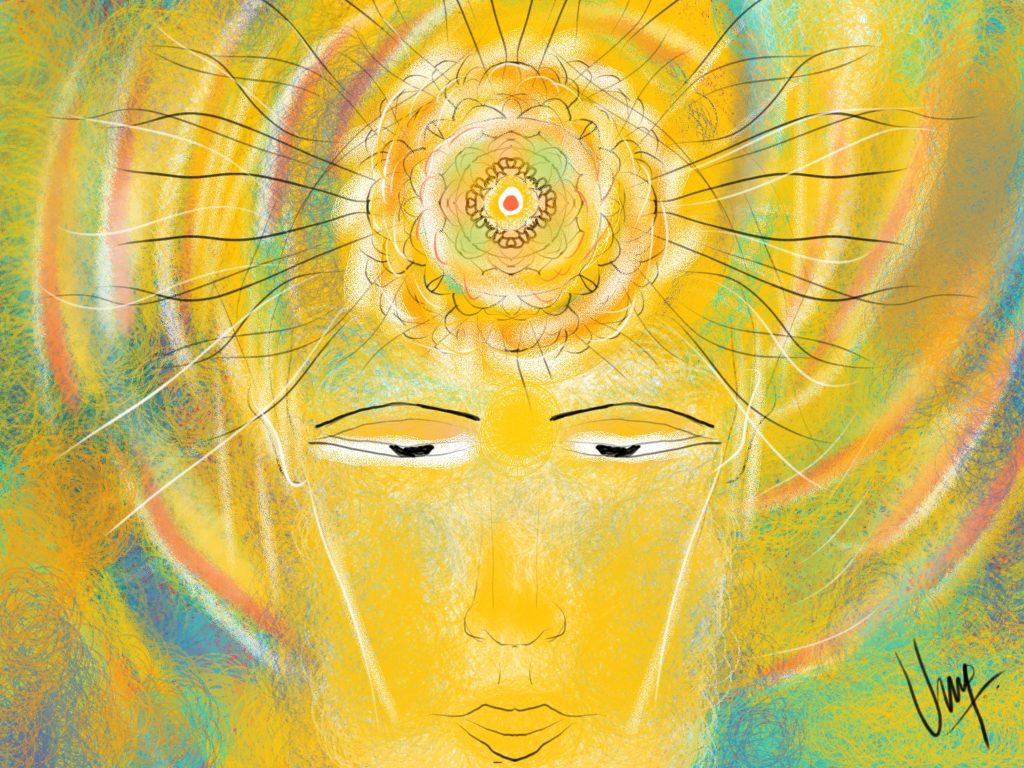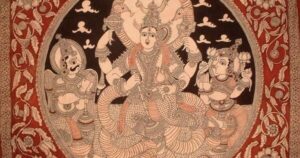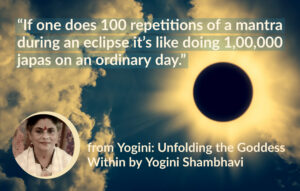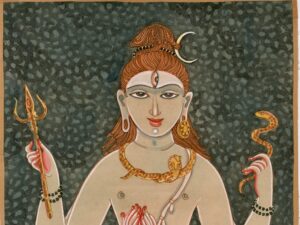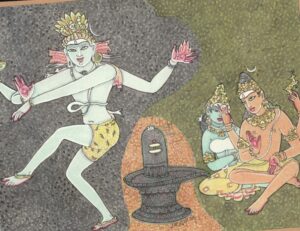The great spiritual traditions of India commonly teach us that the world is Maya, usually translated as ‘illusion’ or ‘unreality’. That the world is Maya is the basis of the emphasis on yoga and meditation in Indian thought, which is regarded as the means of moving beyond Maya.
The idea that the external world is an illusion was greeted by nineteenth century European thinkers as proof of India’s inability to cope with the practical world, but as we move into the high tech era, its media images and virtual realities the twenty-first century, our world is becoming more and more like Maya every day. There is a deep meaning to Maya that must be understood for any true cosmic or self knowledge to develop, including spirituality and science.
Of course, few of us like to have the validity of what we are doing in life challenged or the reality of the world as we see it called into question. But how real is the world that we experience through our senses? Do we see reality through our senses, or are we merely receiving a surface glimpse of something far greater or even different than what it seems? Even if we add the tools of science and the media – with their instruments of greater communication and perception – to the data gained from the senses we may still be getting an incomplete or distorted view of the world, not the world as it is but rather only one side of it, like the proverbial blind men and the elephant.
Science reduces the world to subatomic particles and our body to chemical reactions that deconstructs the reality that appears through our senses and leaves us only with energy moving in space. Media biases are well known to all of us, both in the realms of business and politics, and new forms of communication are coming up regularly that are altering how we see the world. Clearly Maya or illusion is there everywhere around us. It is an obvious fact for all of us – if we but look deeply – that things often end up not really being what they initially appear to be. The world is a shifting seeming, a changing appearance, which hides something different, deeper, invisible or unknown.
This experience of illusion begins at the level of our daily lives. If we go to the store to buy groceries, for example, we commonly note that the actual nutritional value of a food item is usually different than the appearance or even size of the package. In our social interactions, for another example, we often discover once we get to know a person that we find them to be quite different than how they first appeared. We frequently get such ‘reality checks’ in life when we find out that things are not what we thought they were, and we were instead being misled by appearances or by our own expectations. All of this is Maya.
The seeming or illusory nature of the phenomena, events or circumstances in the world is a common fact of our daily lives. Those individuals who are wise do not allow themselves to be taken in by appearances, promises, or marketing. They hold back, wait and observe before making any important judgments or decisions, looking to what may be behind the actions and motivations of others or the circumstances involved.
In the modern world, we live in a turbulent ocean of appearances, impressions and influences. Unless we learn to probe beyond these surface waves, we will unlikely find the truth of life and will often be deceived, not only by others but also by ourselves, as each one of us has his or her illusions about self and world as well.
The Wonderful Maya of Nature and the Dangerous Maya of Society
There are two levels of this Maya of the world. The first is the Maya of the world of nature, which holds a wealth of beauty and grace behind the appearances of the various landscapes that we take for granted – the magic of the mountains, rivers, ocean, sky and stars. Nature is a Maya of beauty and wonder, intimating a yet deeper cosmic reality. This Maya of nature can help us develop spiritually once we learn to decode its symbols and subtle processes and learn how to mediate deeply upon it.
The second and more difficult level of Maya is the Maya of the human world which contains various hidden influences, control mechanisms and power games behind the social, economic, political, intellectual, religious and spiritual influences that make up our social order.
The Maya of nature is not hard to deal with, but we prefer to ignore it because it requires a greater effort to probe behind nature’s mysteries. It is the Maya of our human world that is our main preoccupation, challenge, fascination and problem. In our social interaction, as we all know, there is much posturing, role playing, pretending or even outright deception going on. Those who are gullible and naïve often find themselves taken advantage of.
We see this Maya easily in the sphere of human relationship. A woman tries to look beautiful going out for her first date, hiding her blemishes or emotional instability. A man not only tries to look good but likes to exaggerate his achievements in life or his income. In the work sphere, we also have much illusion to contend with. People want to make a good impression in order to get a job, exaggerating their resumes, but are happy to be lazy with a job that we have become accustomed to. Bosses also exaggerate their roles or their importance. We can all think of many such instances in our own lives.
In the marketing world, we are easily taken in by advertising and the endless pursuit of bargains and sales. Get rich quick schemes remain ever popular for both the young and the old, and casinos still litter the landscape in some regions. People regularly pay for lottery tickets though their actual chance of winning is minuscule. We are entertained by gambling away our money, particularly if we are made intoxicated along the way.
Not only can the appearances that we encounter in life be deceptive, we are ever ready to project our own desires and fantasies, our own illusory appearances on the world. Our expectations of what we are worth are often greater than our actual skills or capacities. We may want an ideal partner but do not feel compelled to become an ideal person ourselves. The list is endless. Yet sometimes we undervalue ourselves. We accept a job, salary or relationship that is far beneath our actual skills or potentials, held back by fear, insecurity or a lack of self worth that is not real.
Every person we encounter and every object we see hides a deeper story or mystery. We may know a person by name as our neighbor but there are other aspects of their lives that we do not know, both good and bad. Most importantly, we don’t even fully know ourselves. Apart from our familiar self, we have many other potentials and skills. We are capable of different jobs, living in different places or even assuming different identities in life. Moreover, there are depths of awareness inside us that are cosmic. We have an inner being beyond the time space and karma of our apparent self.
When we are talking about other people, particularly when we are gossiping, we are talking about their appearances, not their deeper reality. Most of us are caught in a superficial view of the world and of ourselves that accepts the familiar as real, and eventually confines us in monotony and boredom. Our sense of familiarity defeats us in life and confines us to self-imposed limitations and boundaries, confusing our habitual responses with the greater truth of things.
Metaphors of Maya: The Misperceptions of Our Lives
In yogic thought, several metaphors are used to show the illusion of our lives: There is the example of a person walking down a dark road at night who mistakes a coiled rope for a snake and becomes deathly afraid. Most of our fears in life are similarly misplaced. In our higher Self, we do not need anyone or anything and can be perfectly at peace as we are. Yet we are easily made afraid if there is uncertainty and insecurity in our outer lives, though these are inevitable in the changing and unpredictable world in which we live.
There is the complementary example of a personal walking along a beach who confuses a glittering piece of a sea shell for a silver coin. This reflects how we project our desires on to life. We often get what we want in life and then find out that it is actually something different that we don’t want because we didn’t examine it properly to begin with.
Another important example is dream. There is a certain dreaminess about life. In fact, once an experience is over for us, it seems little more than a dream. Think of your childhood, for example. It is little more than a dream for who you are today. Our waking state is but a longer dream that we are dreaming with others. Much of our lives consist of fantasies, particularly in the fantasy world of the media, movies and computer games. Most of us are happier in this fantasy realm than in our daily lives.
Yet even if our minds are not projecting any fears or desires, our senses reveal only a snapshot from a particular point in space and time. No matter how many snapshots we put together, we cannot get a view of the whole. All our sensory perception by its partial nature easily lends itself to misperception.
Another example of the Maya of our lives is a rainbow. A rainbow looks beautiful in the distance but when you go closer it, it disappears. It is only an optical illusion. There are many rainbows in our lives. Some are illusions based on how we look at the world, but others are indications of yet greater realities that we cannot see.
Yet another example of Maya is that of a pot made of clay. We see the pot and forget that it is nothing but clay. We can compare this view with seeing an ornament made of gold. In this case, we see the gold and forget the ornament. We are often caught up in the name, form and usage of things and forget what they are really made of.
And through all these seeming appearances there is the greater fact of impermanence. Everything in life is changing, some things slowly, other things quickly. We often find that things have unexpectedly changed for us in life, which shocks us or causes us suffering. Yet even we change and sometimes unexpectedly for others, fracturing their world view and sense of security.
Understanding Maya and Living in the Great Mystery
The result of this blind taking of appearances as real is that we stop seeing things in life. We don’t see our spouse, much less the tree by the side of our house, because we are used to them and expect them to always be there in a certain way for us. Yet our habitual view of the world is ever breaking down by accidents, diseases, unexpected social problems, weather changes, natural calamities and so on, leading to the ultimate fact of our own death.
The fact is that the world is unpredictable, not consistently what it appears to be. While forces may continue in a certain direction for a time, they can quickly change directions as well. Even in our daily lives we have the day and the night and their quick alternation from one to another. This unpredictability of life, though it causes us many problems, is not necessarily bad. The world is a magical place that we never need get bored with, if we are willing to look anew at every movement. What we see outwardly are only symbols, indications and connections with something greater, ultimately with the entire universe. All the things that we come in contact with are but doorways to a deeper reality, not the reality themselves. The question is whether we open these doors or take the door itself as final and never walk through it to the other side.
We should always try to probe more deeply in life starting with the everyday factors of our daily experience from our own thought, breath and action. When you see someone well known to you next time, for example, look a little deeper and you will find something new or different about them. When you go out into nature the next time, try to look beyond the veil of appearances to the inner light, law and intelligence through which nature works.
We live in a world of Maya, which means a universe of great mystery, magic, hidden dimensions, secret energies and occult forces. Most of these forces are beneficent, with a certain delight that can be found at the core of all that we come into association with. Yet there are dangerous forces, negative emotions, and manipulative energies as well that we should not underestimate. Spiritual sciences like Yoga or Vedic astrology help us understand and work with both these positive and negative energies, enhancing the positive and protecting us from the negative. The ignorant see only the surface of life and are content with a surface view of themselves. The wise take nothing for granted and always look more deeply, finding a vastness everywhere within and without.
So do not shut down your deeper vision. When you see something familiar; look deeper and let go of old judgments and expectations. When you see a person, think of the entire life of that person, not only what you know of them but what new potentials they might have. When you see a tree, think of the life of the tree and how it connects to the ground, the air, the Earth, the Sun and the rest of nature. Try to see the deeper energies behind things, including their auras and energy fields, the mystery of light and color that enshrouds everything.
The world is a magic show filled with wonder, including depths of wisdom and delight to share with us, if we but part the veil of appearances and look behind not only the forms of the outer world but the movements of our own minds. Even the great discoveries of science are based upon probing behind appearances to see how things tick. The artist similarly possesses a deeper vision of the beauty behind the appearances of the world. Yogic spirituality allows us to sense the light of consciousness that permeates everything.
So give up your sense of familiarity, your conclusions and opinions, likes and dislikes, the idea that you really know who you are or what the world really is. The deeper reality is unknowable to the mind and cannot be put into words. It can only be experienced in the heart as the mystery that it always will be.
If we see the world as Maya or illusion at its surface, we can discover the depths of Brahman or the cosmic reality wherever we look. We can find the whole in each part, the eternal in a moment, the infinite in a point, the entire universe in every object. All that we see is sacred and divine, a display of vibrations, in which creatures and objects arise like patterns in a kaleidoscope only to dissolve back again into the light. We are the light behind appearances that is also the light through which we see. That light alone remains and yet in it nothing is ever lost.
To see the world as Maya means to look through that Maya to the Divine presence behind it, through which its wonder, delight and transformational power can unfold. The reality is known for those who do not think they know, and it is unknown to those who think that they know. True knowledge is not information about appearances; it is knowledge by identity, in which we become one with all that we see. It requires that we see with the light of the heart, not with the memories of the mind. We must learn to look beyond the illusion of multiplicity to the One Being, the inner Self that shines radiant through all.
Understand the Maya of your life, not only to take you beyond all illusions, but to enter into the supreme magic of Being-Consciousness-Bliss, the cosmic reality, which is present everywhere and at all times.

